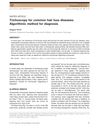Search
forLearn
5 / 6 resultslearn Epidermal Growth Factor
learn Hair Multiplication
extract, clone, and reinsert your own hair cells
learn RU58841
a potent but unapproved and potentially problematic topical anti-androgen
learn Biotin
supplement to help with hair texture and quality
Research
5 / 1000+ results
research Trichoscopy for Common Hair Loss Diseases: Algorithmic Method for Diagnosis
The conclusion is that an algorithm using trichoscopy helps diagnose different types of hair loss but may need updates and a biopsy if results are unclear.

research Fibrosing Alopecia in a Pattern Distribution
Fibrosing alopecia in a pattern distribution is a unique hair loss condition that may respond to antiandrogen therapy.

research Permeation of Topically Applied Caffeine Through Human Skin – A Comparison of In Vivo and In Vitro Data
Caffeine penetrates human skin in lab tests similarly to real-life conditions, but actual skin use is still essential for accurate results.
research Sebaceous Gland, Hair Shaft, and Epidermal Barrier Abnormalities in Keratosis Pilaris with and without Filaggrin Deficiency
Keratosis pilaris is often linked to genetic mutations and causes skin and hair abnormalities, regardless of those mutations.

research Lichen Planopilaris: Chronic Scarring Alopecia with Autoimmune Component
Lichen planopilaris is a chronic, scarring hair loss condition with no definitive cure, requiring accurate diagnosis and treatment to manage symptoms.
Community Join
5 / 111 resultscommunity My experimental hair loss journey under medical supervision: finasteride/dutasteride, oral/topical minoxidil+tretinoin (3-month progress and hair transplant insights for those considering it)
A 23-year-old discusses their hair loss treatment using finasteride, dutasteride, oral and topical minoxidil, and topical tretinoin under medical supervision. They stress stabilizing hair loss before a hair transplant and plan to continue the regimen for at least 18 months.
community DHT Harms Scalp Microbiome: DHT Itch is REAL
Increased Malassezia and Cutibacterium in the scalp microbiome are linked to higher sebum production and inflammation in androgenetic alopecia (AGA). Treatments include ciclopirox shampoo, benzoyl peroxide shampoo, clobetasol propionate, calcipotriol, minoxidil, finasteride, and dutasteride.
community DHT reduction in the scalp for all doses of dutasteride is now available.
Higher doses of dutasteride reduce scalp DHT more effectively than finasteride, but have diminishing returns after 3mg daily and may cause more side effects. Combining dutasteride with topical minoxidil can enhance results, but using both finasteride and dutasteride together is unnecessary.
community My Theory Of Androgenic Alopecia
Hair loss is linked to cellular physiology and the IGF-1 to TGF-B1 ratio, not just androgen sensitivity. The theory lacks evidence, while finasteride and minoxidil are effective treatments.

community Compressed part of research of theory of androgenic/anabolitic balance. AGA h-responders analytic. Theory of physio-metabolitic method of anti AGA treatment
The treatment for androgenetic alopecia involves using finasteride and minoxidil with intense exercise and cold exposure to boost metabolism and reduce androgenic effects, potentially leading to hair regrowth. This approach may activate biological pathways for improved hair and overall health.